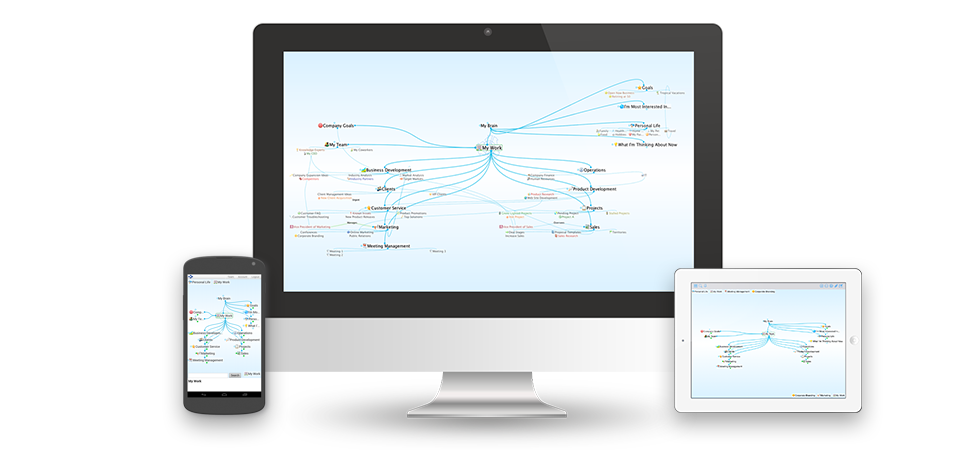
Time to Digitize Your Mind
Getting Started
Creating a New Brain
Working with Thoughts
Creating Thoughts
Thought Relationships
Active Thought
Linking Existing Thoughts
Unlinking Thoughts
Editing Thoughts
Forgetting Thoughts
Attachments
Accessing Attachments
Renaming or Deleting Attachments
Adding Images
BrainBox
Notes
Pins
Adding and Accessing Pins
Removing Pins
Search
Synchronizing Your Brain
TheBrain Desktop Application
Settings and Application Information
TheBrain lets you visualize and connect everything across all your devices. Capture ideas, web pages, files and notes, and always find them - just like you think of them. With TheBrain you will even see related items that would otherwise be forgotten. TheBrain combines the best of note taking, file synchronization and mind mapping apps to give you the ultimate digital memory. It's time to see your ideas like never before with your own digital Brain.

A Brain is a simple and powerful, dynamic map of all your ideas and information. Your Brain can be accessed on all your devices. Your Brain starts with a single Thought. Each Thought can have links to other Thoughts, notes as well as attached files and web pages.
TheBrain's flexible structure allows any Thought to be linked to any other Thought, so you can always see related information. It's simple to make connections between Thoughts so that they reflect the way you think. Your Brain will go more and more powerful with each new Thought and connection!
If you have already created a Brain on the desktop app and synced it to TheBrain Cloud, or created a Brain in TheBrain Web Client, you will see these Brains available for download in the Android app. Just tap on the brain thumbnail from your Brain list and start the download. From the mobile app, you can also create a new Brain from scratch.
New Brains can be created from the Brain list.
Tap the Brain+ icon  in the upper-right of TheBrain.
in the upper-right of TheBrain.
Type in the name of your new Brain then tap Create.

Your Brain will be created and automatically open to a Thought matching its name.
Now that you have your first Thought on your Brain you can create other Thoughts for all the key aspects of your life.
What is a Thought? TheBrain lets you organize all of your ideas and digital information visually with Thoughts. A Thought can be an idea, a link to a web page, or file. You can create as many Thoughts as you like to organize your information the way you think.
New Thoughts can be created from the toolbar section of TheBrain.
Tap the  icon displayed in the lower section of the screen.
icon displayed in the lower section of the screen.
Choose a relationship for your new Thought.
Enter a name for your new Thought and tap Create.

Your new Thought will be created in the relationship location selected.
You can also create multiple Thoughts at once, using a semicolon (;). Simply type the name of each Thought you want to create and separate each with a semicolon.
Once you have all the Thoughts you want typed out, tap Create.
All your Thoughts will be created at once.
The topics that you link together and are displayed in your Brain are called Thoughts. Thoughts are the basic units of a Brain.
A Thought can represent anything you want it to. It can include an icon, note, attachments (such as files and Web sites) or it can have no content at all and simply act as a subject heading or organizer. Minimally, a Thought has a name.
When you tap a Thought it moves to the center and it becomes the Active Thought.
A Thought is said to be a "parent Thought", "child Thought", "sibling Thought", or "jump Thought" based on its relationship to other Thoughts with which it is linked. In your own life, you may be someone’s parent, and someone’s child, and someone’s sibling, and someone’s peer, adviser, or colleague. So, who are you? The answer to that question is relative - it depends on the circumstances and what hat you’re wearing at the moment.
All Thoughts fall under one of three main relationships; Child, Jump, or Parent. There are also Sibling Thoughts, which are Child Thoughts that share a common Parent.
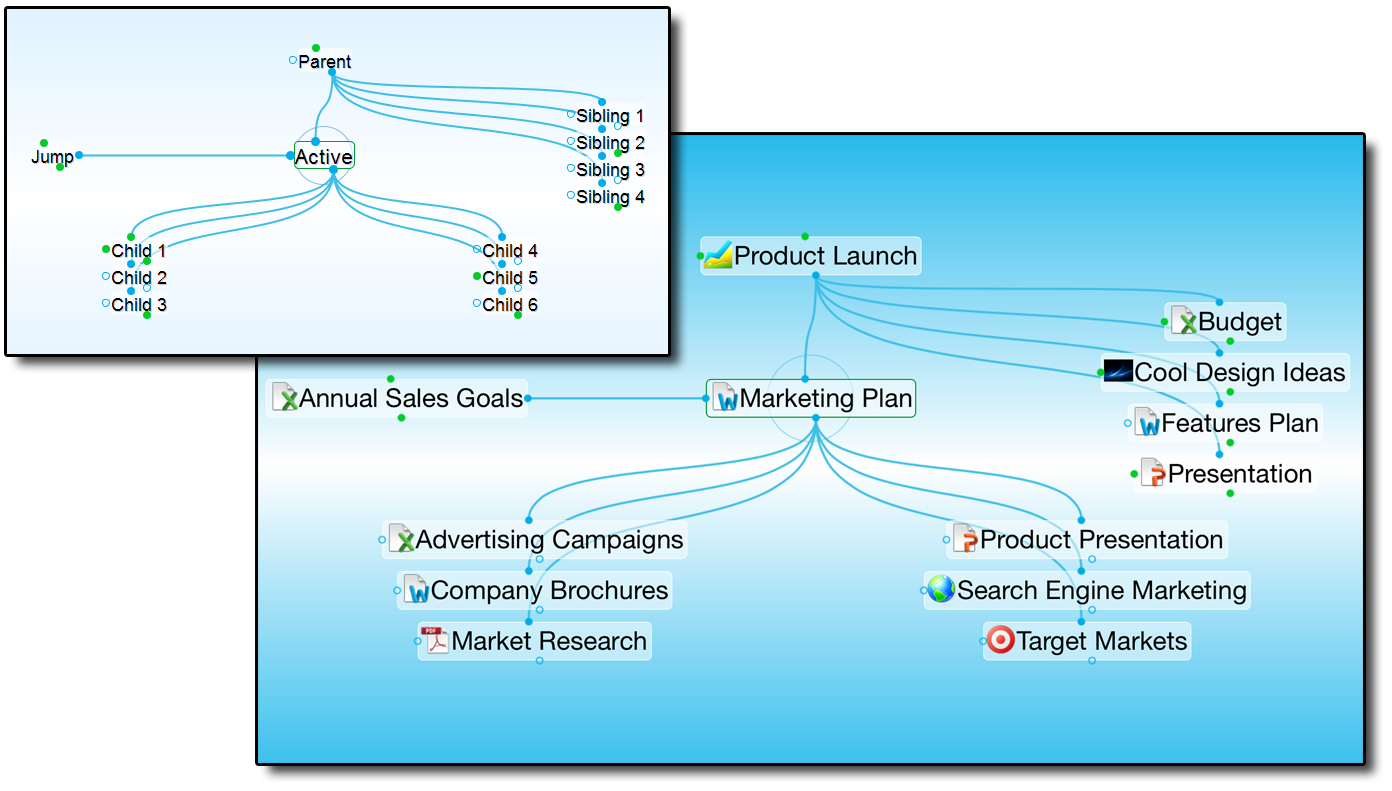
Child Thought - Child Thoughts are subtopics of the active Thought. They appear in the "child zone", below the active Thought. In the picture above, the active Thought "Marketing Plan" has six child Thoughts.
Jump Thought - Jump Thoughts are related to the active Thought but are neither child nor parent topics. They appear in the jump zone to the left of the active Thought. Jump Thoughts have an "equal weight" relationship with the Thought to which they are related. For example, as shown above, "Marketing Plan" has the various categories such as "Market Research", "Target Markets", "Company Brochures" and "Product Presentation" linked as child Thoughts since they are subcategories of Marketing Plan. "Annual Sales Goals" directly affects the Marketing Plan, but it is not a subcategory itself. Therefore, it makes a perfect jump Thought-related, but not part of the main Thought grouping.
Parent Thought - Parent Thoughts represent super ordinate topics of the active Thought. They appear in the parent zone, above the active Thought.
Sibling Thought - Sibling Thoughts share a parent with the active Thought. They appear in the sibling zone, to the right of the active Thought. In the picture above, "Cool Design Ideas" and "Features Plan" are siblings of "Marketing Plan" because they are all children of "Product Launch".
The Active Thought is the current focus of your Brain at any time. An outline and a circle behind the Thought indicate an Active Thought.
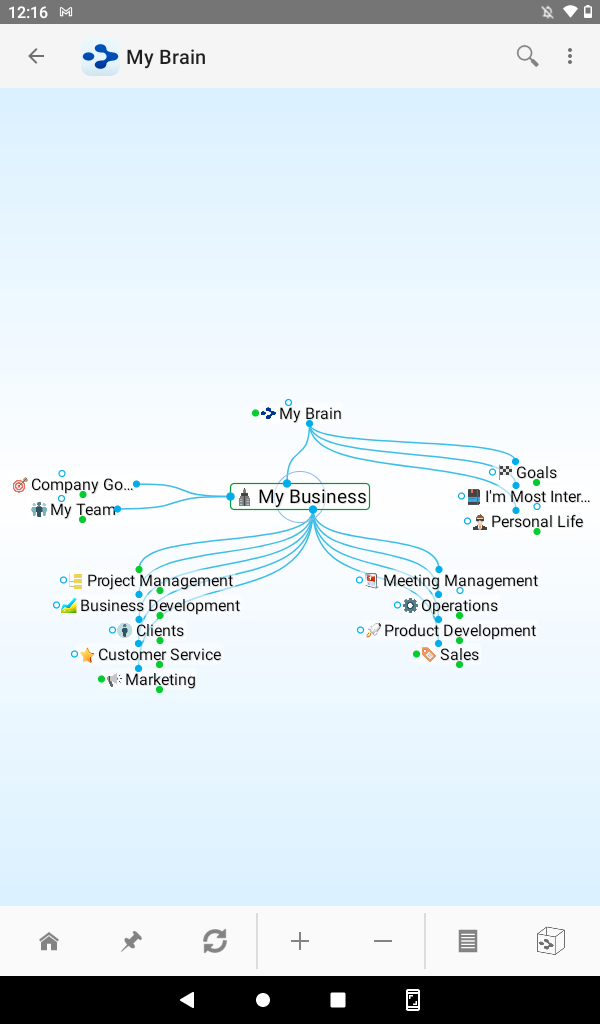
'My Business’ is the Active Thought in the example shown above.
Existing Thoughts can be linked from the toolbar section of TheBrain.
Tap the  icon displayed in the lower part of the screen.
icon displayed in the lower part of the screen.
Type in the name of an existing Thought.
Existing Thoughts matching your text will be displayed below what you are typing in the Create... menu.
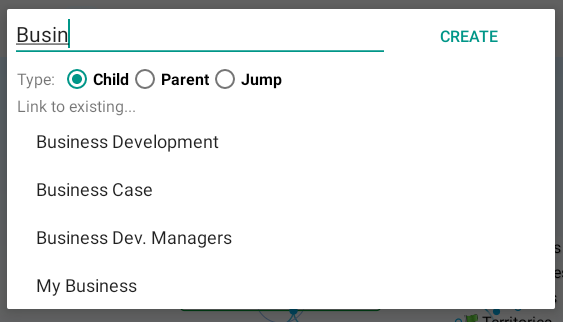
Choose a relationship for your Thought.
Tap the Thought you would like to link to and it will be linked to your Active Thought.
Thoughts can be unlinked from the toolbar section of TheBrain. Keep in mind, any Thoughts that are unlinked from all other Thoughts will be considered an "orphan" Thought and can only be found via Search or while linking to an existing Thought.
Activate any Thought linked to the Thought you wish to unlink.
Tap the  icon displayed in the lower section of the screen.
icon displayed in the lower section of the screen.
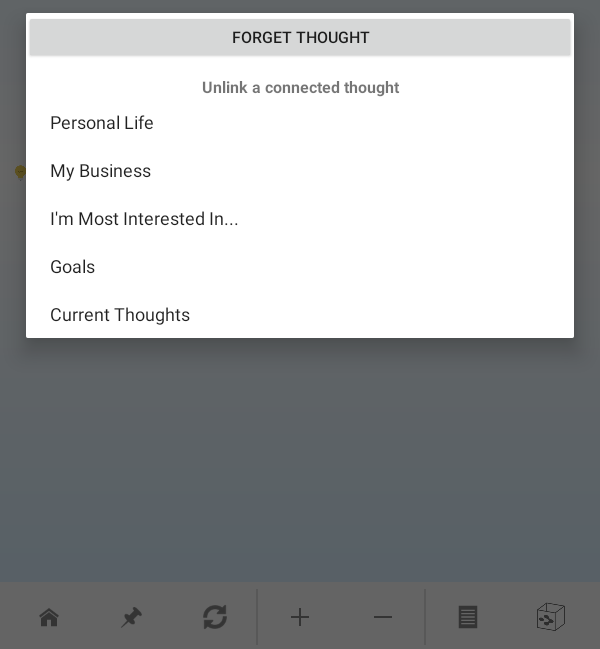
Tap the name of the Thought you wish to unlink.
Thoughts can be edited by tapping the Thought name when it appears as an Active Thought. The name, color, Type or Tag settings can all be edited.
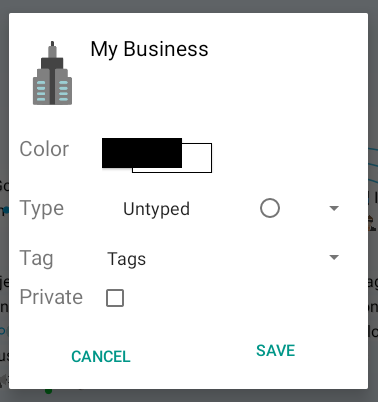
Thoughts can be forgotten from the toolbar section of TheBrain. When a Thought is forgotten, it can be remembered later via TheBrain desktop application.
Navigate to the Thought you wish to forget.
Tap the  icon displayed in the lower section of the screen.
icon displayed in the lower section of the screen.
Tap Forget Thought
 .
.
If your Thought has an attachment, the attachment icon  in the toolbar section of TheBrain will appear highlighted
in the toolbar section of TheBrain will appear highlighted  .
.
There are two methods you can use to access your attachments.

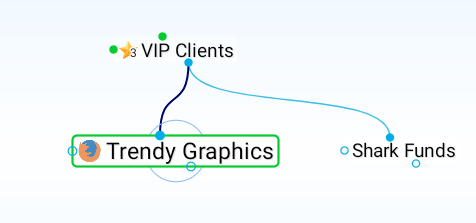
Tapping the icon will launch the attachment. Keep in mind, not all attachments originally attached in the desktop application of TheBrain may be able to launch in Android.
If multiple attachments exist, or if you tapped on the paperclip, the content page will be displayed with attachments available above the note.
You can then tap on any of your attachments to view them.
You can remove or rename any attachment from the toolbar section of TheBrain.
Tap the  button in the toolbar section of TheBrain to access the content page. Long press on any attachment. You will then have the option to Delete, Rename or Preview.
button in the toolbar section of TheBrain to access the content page. Long press on any attachment. You will then have the option to Delete, Rename or Preview.

Deleting an attachment will require a confirmation
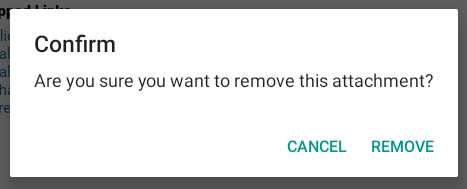
You can add an image attachment from the toolbar section of TheBrain.
Navigate to the desired Thought and tap the attachment icon  in the toolbar section of TheBrain.
in the toolbar section of TheBrain.
Tap on the attach/insert button in the toolbar. 
Tap either the Insert Image (to place image inline with the note), Attach Image or Attach from Camera option from the menu.

If you selected Take Photo, your camera will automatically launch. Take a photo or tap anywhere outside the camera if you change your mind.
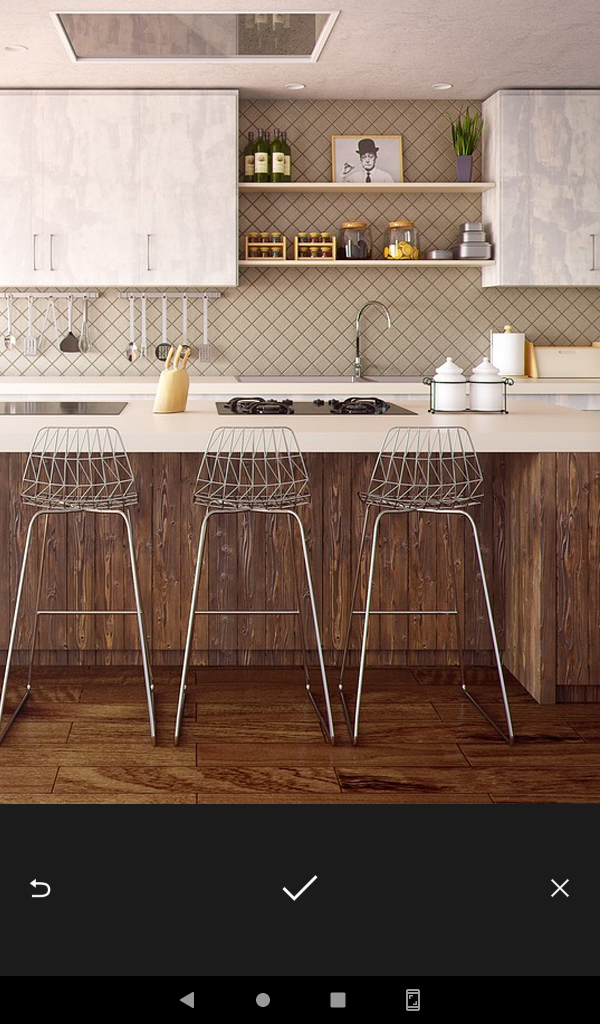
If you are not happy with your result, you can tap  to take a new photo. Once you've taken a photo you like, tap
to take a new photo. Once you've taken a photo you like, tap  and it will automatically be added to your Thought as an attachment.
and it will automatically be added to your Thought as an attachment.
You can add a file to your Brain from Chrome or any other location by sharing it with TheBrain via BrainBox. This will add the file or web page to your BrainBox list where it can then be connected to a Thought at a later date as an attachment.
To add a website, open the desired web page in Chrome then tap on the context menu button and select the  button. Select TheBrain option in the list.
button. Select TheBrain option in the list.
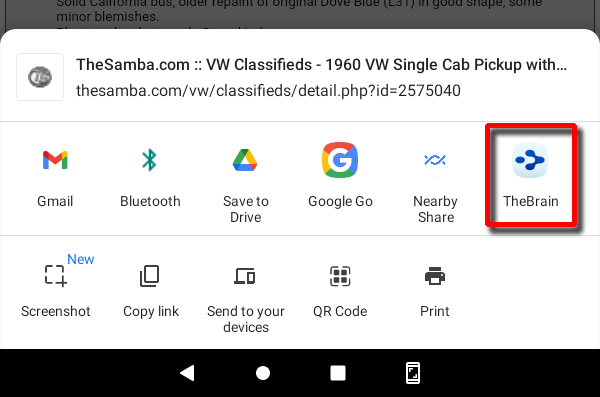
Return to TheBrain app at any time. Open a brain and navigate to the Thought or parent Thought where your attachment will reside. Tab the BrainBox button in the toolbar.

You will see a list of all documents and web pages that have been added into your BrainBox either from your mobile device or from your desktop. Select the desired attachment and tap Actions to Preview, Attach, Create a new Child Thought or Remove.
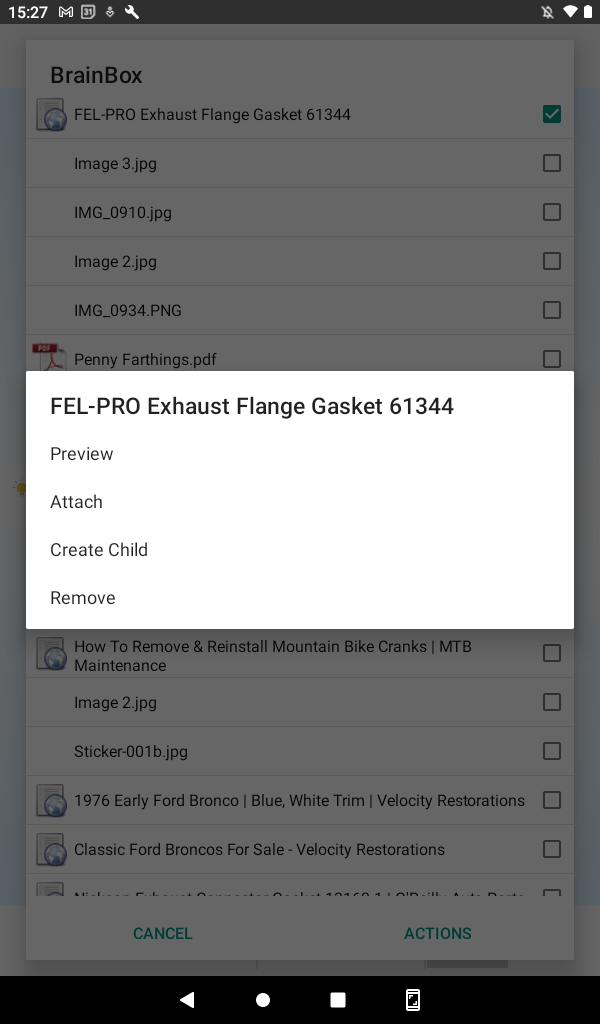
Attaching or Creating a new Child will add this attachment into your Brain and remove the item from BrainBox
Notes can be extremely useful for annotating or expanding information about your Thoughts.
Notes can be added to a Thought from the toolbar section of TheBrain.
Tap the  icon in the lower section of TheBrain.
icon in the lower section of TheBrain.

The Notes area will appear.
Tap anywhere in the notes field to call up your keyboard and type a note.

Notes in the mobile app use the same Markdown formatting as the desktop application. Use the buttons in the toolbar for formatting text. Some options are combined into a single button in the toolbar.
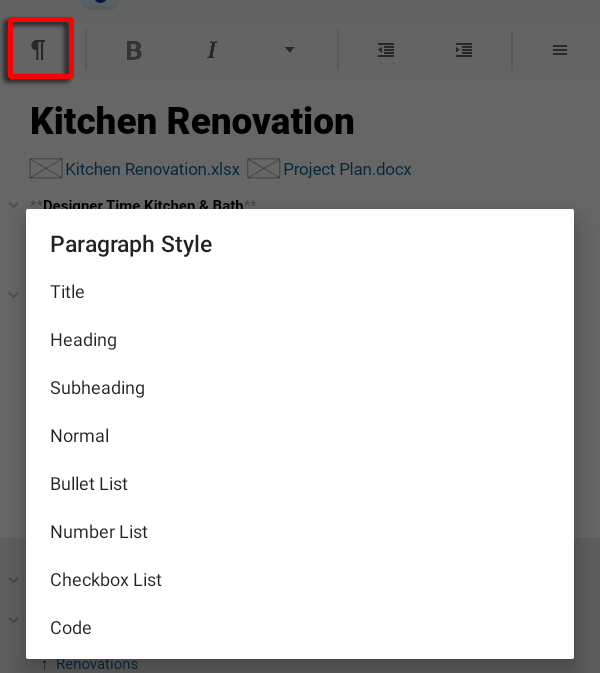

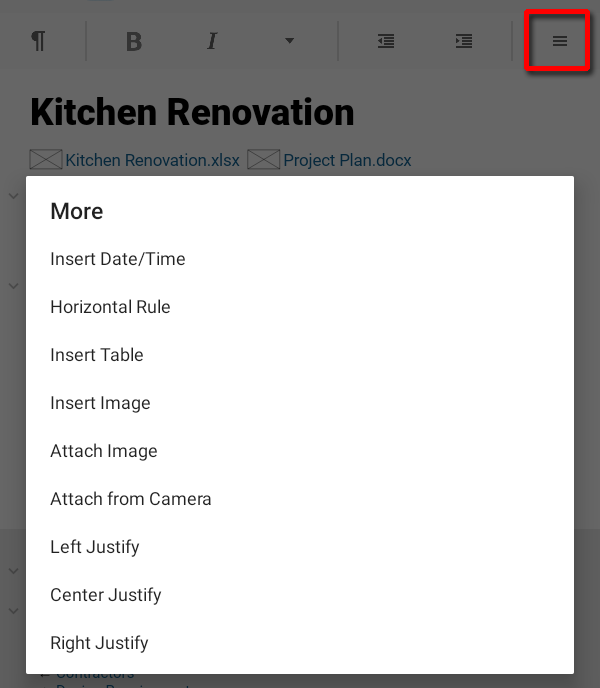
TheBrain Markdown Reference Guide can be found at https://www.thebrain.com/docs/markdown-info
When finished, tap Back. You will automatically be taken back to your Thought and the Note icon will be highlighted to confirm you have a note associated with that Thought.

You can tap the Notes icon  in the toolbar to access the Notes section again in the future.
in the toolbar to access the Notes section again in the future.
The  icon in the toolbar can be used for adding Pins. Pins act like a bulletin board on which you can "thumbtack" Thoughts you want to keep at your fingertips. No matter where you are in your Brain, the pins remain easily accessible.
icon in the toolbar can be used for adding Pins. Pins act like a bulletin board on which you can "thumbtack" Thoughts you want to keep at your fingertips. No matter where you are in your Brain, the pins remain easily accessible.
Pins can be managed from the toolbar section of TheBrain.
To add a Pin, activate any Thought you would like to Pin.
Tap the  icon in the toolbar.
icon in the toolbar.
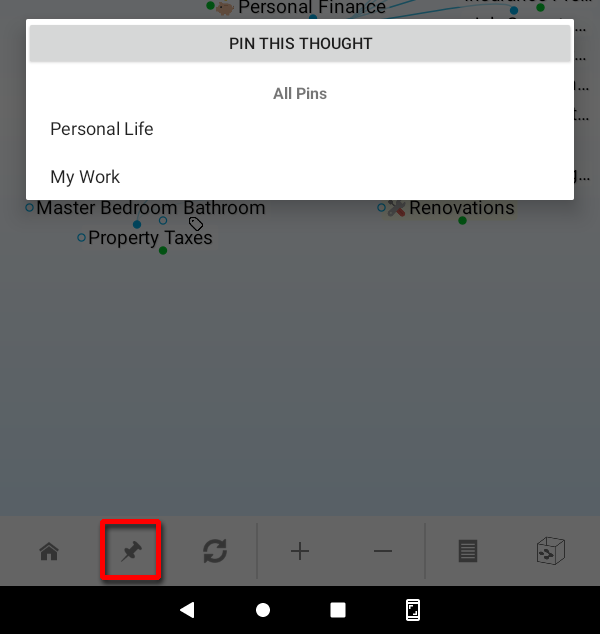
Tap Pin this Thought. The current active Thought will be added to your list of existing pins. Tap the  icon at any time and then tap a Thought name in the list of existing pins to navigate to that Thought in your Brain.
icon at any time and then tap a Thought name in the list of existing pins to navigate to that Thought in your Brain.
Navigate to a Thought that is already displayed in your existing pins list. Tap the  icon. Select the option to Unpin this Thought
icon. Select the option to Unpin this Thought
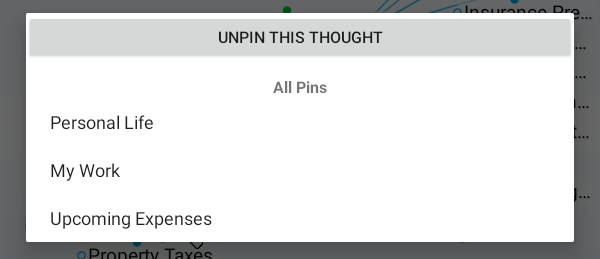
TheBrain's Search feature lets you quickly find a Thought by typing a few letters, and choosing from a list of results.
Tap the  icon in the upper toolbar of TheBrain.
icon in the upper toolbar of TheBrain.

Type in the name of an existing Thought.
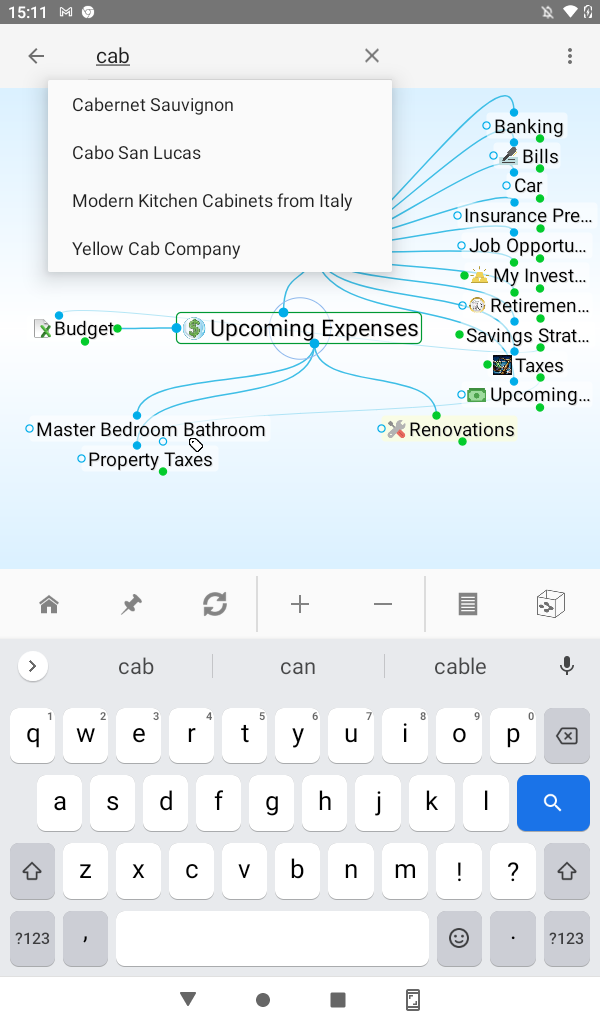
Tap any Thought in the results list and it will be automatically activated.
With TheBrain and TheBrain Cloud Services you can use your Brain on multiple devices and synchronize changes. Any changes you make to your Brain on one machine will be reflected on every other machine through synchronization!
Syncing to TheBrain Cloud Services from TheBrain mobile app is easy. Any changes you make in the TheBrain mobile app are automatically saved for viewing on TheBrain Cloud.
Auto sync occurs every few minutes in the background, or when the app opens and closes. To manually sync a Brain, tap the sync icon  in TheBrain toolbar. To view your Brains online, visit TheBrain website and login via your desktop web browser.
in TheBrain toolbar. To view your Brains online, visit TheBrain website and login via your desktop web browser.

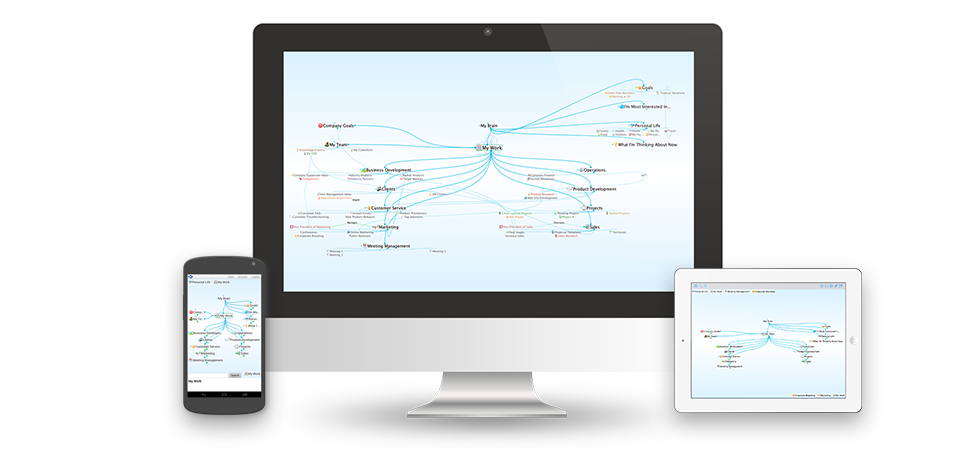
Any changes made to your Brains, on your mobile device are synced and saved to TheBrain Cloud Services. You can view your Brains on multiple devices that are synced through TheBrain Cloud Services, including other mobile devices using TheBrain and even your computer using TheBrain desktop application.
TheBrain mobile application is only the beginning. TheBrain desktop software offers even more, for deep editing and creation on your computer. To view and edit your Brains on your computer, download and install TheBrain desktop software from TheBrain website.
Once you install the desktop application and log in, you will see a list of all Brains you've created and synced using TheBrain mobile application.
To start using one of these Brains locally, click the thumbnail for this brain to download to your desktop.
TheBrain software will automatically download your Brain from TheBrain Cloud Server and will be set to sync automatically to keep all changes made from either your mobile device or your desktop in sync.
You can return to your list of available Brains at any time by tapping on the home button in the toolbar.

From the Brain list, tap on the context menu button to review your version number or account information where you can log out of the app if necessary.
